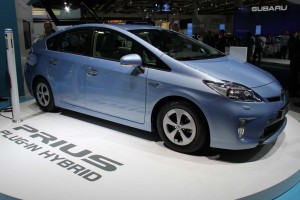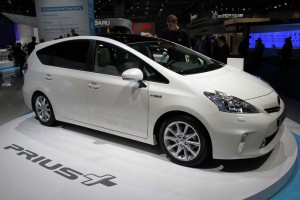Underscoring the small but fast-growing presence of hybrids in Europe, Toyota brought its Prius Plug-in to Europe for its official world debut this week.
The plug-in will become part of an expanding “family” of hybrids sharing the Prius name, Didier Leroy, President of Toyota of Europe, told an audience at the Frankfurt Motor Show. Set to reach the U.S. market, as well, in the coming months, the Prius Plug-in will have a larger battery pack than the conventional Toyota hybrid to permit it to drive longer distances in pure electric vehicle mode.
Range will still be a modest 14.5 miles in battery mode – and will restrict the vehicle to speeds of around 60 mph. That’s in sharp contrast to the Chevrolet Volt “extended-range electric vehicle” and its European sibling, the Opel Ampera, which get about 35 miles on a charge and can be used in electric mode at speeds up to around 90 mph.
Toyota, however, plans to sharply undercut the price of the two Detroit offerings. Though the maker won’t reveal figures until closer to launch industry analysts expect something around or under $30,000 in the States – minus the federal $7,500 tax credit. That could mean a buyer would get a plug-in from Toyota for about $10,000 less than a Volt.
In Europe, Leroy said the Plug-in will cost less than 37,000 Euros, still a significant discount compared to the Ampera. The popularity of the standard Prius, meanwhile, should enhance the new model’s appeal, he suggested.
The European version of the Toyota Prius Plug-in will reach market slightly later than the U.S. model, sometime during the first half of 2012, according to Leroy.
The question being widely debated is whether the Toyota Prius Plug-in provides truly measurable benefit for the added cost. In Europe, it may have more appeal based on dollars-and-cents calculations since motorists typically commute shorter distances. In the U.S., the Chevy Volt is expected to be able to handle about 70% of commuters’ daily travels. The Toyota Prius Plug-In will cover less than a third.
Still, the vehicle is expected to appeal to green-minded buyers who want to do anything possible to reduce fuel consumption. The new Toyota plug-in is expected to carry a equivalent fuel economy rating in the range of 100 miles per gallon (2.1 liters per 100 kilometers in the European test cycle) once its numbers are formally approved. It produces about 49 grams o0f CO2 per kilometer, a fraction of what even the best European gas and diesel-powered models are pumping out.
The basic technology underlying the Prius Plug-in is largely the same Hybrid Synergy Drive found in the standard model – with the key difference being the use of a larger lithium-ion battery instead of the less energy-dense nickel-metal hydride battery in the standard-issue Toyota Prius.
Toyota plans to have “no less than nine” hybrids in its European Toyota and Lexus line-ups in the coming year.
But it won’t be alone. A growing number of makers are adopting battery drive systems and among those looking to offer plug-ins are makers like Ford, Honda and BMW. The latter formally introduced its new “i” line of battery cars during this year’s Frankfurt Motor Show media preview.


